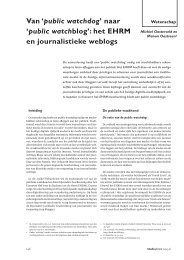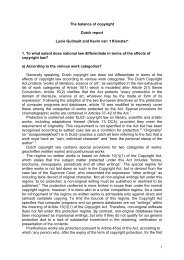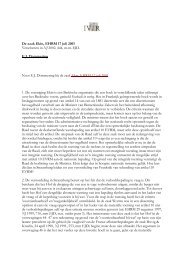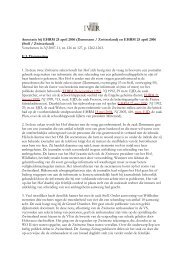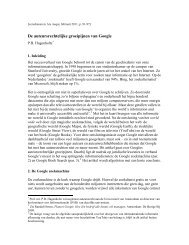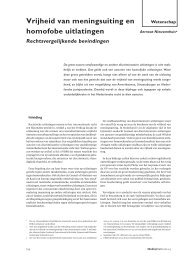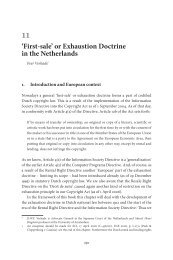unravelling the myth around open source licences - IViR
unravelling the myth around open source licences - IViR
unravelling the myth around open source licences - IViR
You also want an ePaper? Increase the reach of your titles
YUMPU automatically turns print PDFs into web optimized ePapers that Google loves.
4.2 Parties to <strong>the</strong> agreement<br />
A more complex issue concerns <strong>the</strong> identification of <strong>the</strong> parties to an <strong>open</strong> <strong>source</strong> licence.<br />
Whereas <strong>the</strong> identification of <strong>the</strong> licensee poses no great difficulty – it is <strong>the</strong> person who receives a<br />
copy of <strong>the</strong> software – that of <strong>the</strong> licensor can be problematic, mainly because <strong>the</strong> text of <strong>the</strong> licence<br />
does not always contain a clear indication of <strong>the</strong> name(s) and address(es) of <strong>the</strong> physical or legal<br />
person(s) granting <strong>the</strong> licence. The lack of proper identification of <strong>the</strong> licensor could have practical<br />
consequences at least in two situations: first, in relation to <strong>the</strong> enforcement of <strong>the</strong> purely contractual<br />
obligations deriving from <strong>the</strong> licence; and second, in relation to <strong>the</strong> proper functioning of <strong>the</strong> sharealike<br />
clause of <strong>the</strong> GPL.<br />
In <strong>the</strong> first case, we believe that a sharp distinction should be made between <strong>the</strong> copyright<br />
owner(s) on <strong>the</strong> software and <strong>the</strong> licensor(s) of <strong>the</strong> software. As explained more elaborately in<br />
section 5.1 below, <strong>the</strong> identity of <strong>the</strong> copyright owner is a factual question, which must be decided<br />
on a case-by-case basis and which must take into account subsequent transfers of rights. Since we<br />
generally regard <strong>open</strong> <strong>source</strong> licence agreements as contracts, <strong>the</strong> identity of <strong>the</strong> licensor must be<br />
established according to <strong>the</strong> principle laid down in <strong>the</strong> Haviltex case, i.e., taking <strong>the</strong> respective<br />
expectations of <strong>the</strong> parties into account. In principle, <strong>the</strong> licensor and <strong>the</strong> copyright owner can, but<br />
need not necessarily, be <strong>the</strong> same person for <strong>the</strong> licence to be valid. Moreover, even if <strong>the</strong> licence<br />
must be considered as a whole, this does not take away <strong>the</strong> fact that a number of obligations<br />
contained in a typical <strong>open</strong> <strong>source</strong> licence may be regarded as <strong>the</strong> exercise of <strong>the</strong> prerogatives flowing<br />
from <strong>the</strong> copyright protection, but <strong>the</strong> remaining obligations derive exclusively from <strong>the</strong> contractual<br />
agreement itself. For example, <strong>the</strong> GPL imposes a number of contractual obligations on <strong>the</strong> licensee<br />
(such as <strong>the</strong> obligation to disclose <strong>the</strong> <strong>source</strong> code, to distribute modifications of <strong>the</strong> code under <strong>the</strong><br />
GPL, to put a copyright notice with <strong>the</strong> names of all authors and <strong>the</strong> prohibition to ask for royalties),<br />
which have nothing to do with copyright protection. It is not - and will never be - an infringement<br />
of copyright law to do any of <strong>the</strong>se acts. The only way that a licensor can enforce <strong>the</strong>se specific<br />
obligations is on <strong>the</strong> basis of <strong>the</strong> GPL, not on <strong>the</strong> basis of <strong>the</strong> copyright act. In order to facilitate <strong>the</strong><br />
future enforcement of <strong>the</strong> licence, it would <strong>the</strong>refore be important not only to assertain who <strong>the</strong><br />
copyright owner is, but also who <strong>the</strong> licensor is.<br />
Second, <strong>the</strong> lack of proper identification of <strong>the</strong> licensor can make <strong>the</strong> application of <strong>the</strong> sharealike<br />
clause more difficult. According to article 6 of <strong>the</strong> GPL, ‘each time you [a programmer]<br />
redistribute[s] <strong>the</strong> Program (or any work based on <strong>the</strong> Program), <strong>the</strong> recipient automatically receives<br />
a licence from <strong>the</strong> original licensor (…)’. If <strong>the</strong> contact details of <strong>the</strong> licensor(s) are not mentioned in<br />
<strong>the</strong> licence, how can a subsequent user ascertain with whom he is contractually bound? Moreover,<br />
given <strong>the</strong> layered structure of <strong>open</strong> <strong>source</strong> production, it is unclear whe<strong>the</strong>r <strong>the</strong> licensee obtains a<br />
licence only from <strong>the</strong> very last programmer in <strong>the</strong> chain or also from every programmer involved in<br />
<strong>the</strong> development process of <strong>the</strong> particular version of that software. Does <strong>the</strong> GPL licence only bind<br />
<strong>the</strong> last licensee with <strong>the</strong> original licensor or does it also bind all o<strong>the</strong>r developers in <strong>the</strong> chain? For<br />
<strong>the</strong> <strong>open</strong> <strong>source</strong> ideology to reach its objective, one would think that <strong>the</strong> licensee should be<br />
contractually bound to all developers in <strong>the</strong> chain. 146 Again, without proper identification of <strong>the</strong><br />
licensors along every step of <strong>the</strong> development process, how can a subsequent user ascertain with<br />
whom he is contractually bound? The Mozilla Public Licence is perhaps <strong>the</strong> most evident from <strong>the</strong><br />
three types of <strong>licences</strong> examined here. Article 2 of <strong>the</strong> Mozilla licence provides for <strong>the</strong> grant of a<br />
licence to <strong>the</strong> licensee from <strong>the</strong> initial developer, as well as from each contributor.<br />
In practice, a vast amount of <strong>open</strong> <strong>source</strong> software is made available via <strong>the</strong> popular <strong>open</strong><br />
<strong>source</strong> software catalogues, SourceForge, Freshmeat and <strong>the</strong> Free Software Directory. For each<br />
146 De Preter and Dekeyser 2004, p. 216.<br />
37




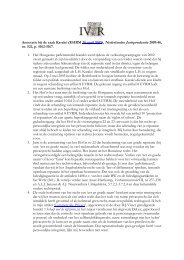

![Legal Opinion of Professor Egbert Dommering [1] concerning ... - IViR](https://img.yumpu.com/23603085/1/184x260/legal-opinion-of-professor-egbert-dommering-1-concerning-ivir.jpg?quality=85)
